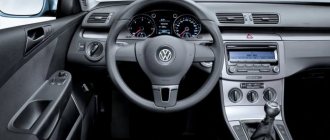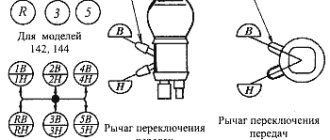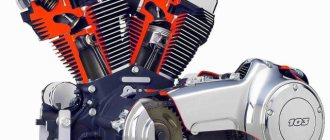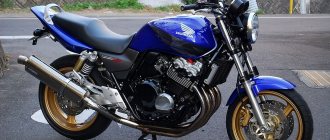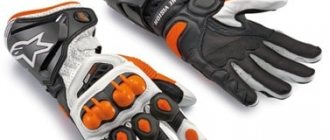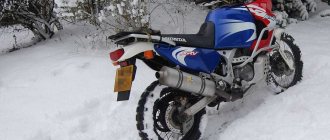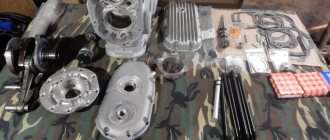Changing speeds is one of the most difficult aspects of learning to ride a motorcycle. Gears are switched sequentially. This can be done only in one order - from bottom to top to gain speed, or vice versa - to reset.
This specificity very often leads to problems for novice motorcyclists. It is especially difficult for those who periodically transfer from a car to a bike and vice versa.
Like any other aspect of motorcycle riding, proper gear shifting requires some experience. Over time, many perform these actions automatically, without thinking about what needs to be squeezed and why.
Until the motor reaches 60-75% of the maximum speed, the speed is not switched. This has several consequences.
Firstly, the acceleration potential will be reduced compared to a correct shift situation. Secondly, engine parts will wear out faster , which will lead to expensive repairs.
When to switch
There are features of how and when to change gears at different gearboxes (“manual” or “automatic”). In any case, you should first study the basic basics, such as the location of the clutch handle, the rules for setting and releasing speed, and the gear shift lever. They are used subsequently to perform these actions.
How to adjust the carburetor on an alpha moped
Running in the Alpha RX 110 moped
Hello everyone! In this article I want to touch on the following topic - running in the new Alfa moped.
After purchasing a new moped, the owner is faced with the question of how to properly break in the engine. This procedure must be carried out on absolutely any equipment, since it significantly extends the life of both the engine itself and the moped as a whole. Four-stroke engines have a number of features that should be taken into account during break-in.
The most common question for the owner of a new Alpha is: how many kilometers must a four-stroke moped travel for its engine to get used to and be ready for long-term use?
Most manufacturers indicate a minimum value of 500 km, but to achieve the maximum effect from break-in, you should drive at least 1000 km in a gentle mode. Only after the odometer shows the coveted number can you safely turn the throttle to full.
During break-in, not only the piston group is ground in, but also the bearings and gears. As a result of controlled wear, the necessary technical clearances appear, which at the moment of maximum load and overheating allow the motor to function normally.
Manual transmission
Beginners always have problems starting a motorcycle, as well as subsequently changing gears. After all, the main question is when to turn on 1, 2, 3 and subsequent speeds when driving. For the first gear, the optimal start will be set at 3 thousand revolutions. (Smoothly release the clutch) They should increase evenly while releasing the clutch. When increasing or decreasing the speed, you must ensure that the speed does not rise quickly. For this reason, everything should be done as smoothly as possible. Growth will be optimal up to 1-1.5 thousand revolutions. If the switching is carried out at low speeds, there will be a need to re-throttle. It is best to perform all actions at high speeds, around -3,000 from the maximum cutoff. The steps look like this:
The clutch lever is depressed and at one moment the gear shift lever is pressed with the left foot. After engaging first gear, gas is gradually added by turning the handle, and the clutch is slowly released.
Using the toe of your left foot, the lever is raised up to a characteristic click at 2nd and subsequent speeds. Some “aces” make the switch in a simpler way: they slightly lift the lever with their toes and release the gas. But this requires some experience for smoothness. Otherwise, the service life of the clutch will be significantly reduced due to increased wear.
It may be necessary to downshift. After releasing the gas by approximately 2,000 - 3,000 rpm by braking, depress the clutch and shift the speed down. This can be continued until neutral is turned on. Smooth operation will only occur when the actual speed is lower by approximately 500 - 1,000 revolutions of the lower gear.
Otherwise, a jerk will be felt.
IMPORTANT: In gears 4 to 6 you can move quite quickly and at maximum speeds. But it will be impossible to move from their place. The reason is the lack of necessary force transmitted to the wheels.
How do you know you changed gear by mistake?
In most cases, you will get a big shock and hear a silly knocking and grinding sound.
This is usually quite inconvenient as you may find that you are also revving your bike too much. This is if you didn't change gear in time.
On the contrary, eventually, if you change gear too early, you'll experience a lack of power and it will take forever to get up to a suitable speed.
Here are a few ways to tell if you've shifted gears incorrectly.
There is no smooth clicking sound. The start of a jerk that causes the bike to eventually stop.
Inequality if a motorcycle is traveling at high speed.
Releasing the clutch suddenly can lift the front wheel off the ground, causing it to skid.
Sudden change in vehicle weight.
Automatic transmission
If we take into account the automatic transmission, there is no need to engage the clutch here, since it is interconnected with the gearbox. For this reason, switching can be performed at any speed while driving. When the gas is released, the gear shift lever is pressed down. There should only be one click for the first transfer. Higher speeds are activated in the same way, but only the lever rises when the gas handle is released (one click). To reset the gears, press the lever downwards. In this case, it is better to do it this way: apply the gas and immediately remove your hand from the handle, and after the speed drops, switch the speed and add gas again in the required amount.
Content
Why is a gearbox necessary? [edit | edit code]
The principle of operation of a gear drive is quite simple. It can be used to change the shaft rotation speed to the currently required value. For example, if the shaft rotates at a frequency of 2000 rpm, and it needs to be reduced by half, then it is necessary to install a drive gear on the shaft and connect it to a driven gear located on another adjacent shaft. If the number of teeth of the drive gear corresponds to half the teeth of the driven gear, then every two revolutions of the drive gear will correspond to one revolution of the driven gear, and the shaft to which it is attached will rotate at a speed half the speed of the drive shaft.
If you apply this to a motorcycle drivetrain, there is another factor to consider. The required driving speed is determined not only by changing the engine speed through a gear drive, it is also determined by the number of power strokes occurring for each revolution of the rear wheel. Thus, in the lowest (1st) gear, the number of power strokes for each revolution of the rear wheel will be greater, and therefore the power will be higher than in higher gears. This is necessary so that the car can overcome the inertia when starting to move, which can be checked if you try to start moving in a high gear.
As we can see, the need to use a gearbox is caused by the characteristics of the internal combustion engine. Let's take an imaginary engine: useful power can be produced in a relatively narrow frequency range from 2000 to 8000 rpm. First of all, it is necessary to reduce this number of revolutions to such speeds that would provide the rear wheel with a normal speed. The required number of revolutions depends on the outer diameter of the wheel, the direct elements of the gearbox and engine power.
For example, if we consider a single speed scooter, we will find that the total gear ratio will be around 15.00:1. This means that every 15 engine revolutions will correspond to one revolution of the rear wheel. This ratio must be selected after the wheel diameter has been determined, taking into account the best use of useful power. If the gear ratio is too high, it will be impossible for the car to move. However, if it is too low, the car will begin to accelerate quickly. but its maximum speed will be limited by the maximum engine speed. On larger displacement and more powerful engines, higher gearbox ratios can be used to achieve higher top speeds, but starting is still a problem. Even though the engine's power increases, its range is limited, forcing the addition of idler gears to increase the overall gear ratio. There must be a certain interval between the gears so that, having reached high speeds in one gear, after engaging the next gear, the engine speed drops to the lower limit of the power range.
It is necessary to be able to select constant gear ratios that stepwise change the degree of reduction in rotation speed. Most cars use four, five or six gears. This number of gears provides a compromise between the ideal ratio spacing and the need for frequent gear changes. Imagine how tedious it would be to change ten gears! What is important is the actual time spent on each shift, during which the car does not accelerate. Probably, such a car would lose to a car with fewer gears in the overall acceleration dynamics. The number of gears is also related to the purpose of the motorcycle. For example, on sports two-stroke engines with a very narrow power band (around 2000 rpm), beyond which there is no useful power, the engine must be operated within this range to make use of useful power. so that the number of transmissions is greater.
What causes the speed change?
When the bike's speed selection lever moves, a special drive allows the forks to move. They are designed to move longitudinal couplings. Two gears cannot be engaged at the same time, since a lock (locking mechanism) is used for this. If we look at the example of a three-way box, while one slider is moving, the rest are simply locked with a lock.
At the moment when the clutch responsible for engagement is directed to the gear of a particular transmission, their ring gears meet. They are connected to each other, and their simultaneous rotation occurs. Thus, the gearbox transmits rotational movements from the engine through the cardan shaft to the main gear.
Changing the oil in the Izh Planet-5 gearbox
Changing the Izh Planet-5 gearbox oil is mandatory periodic maintenance. This means that a similar procedure will have to be carried out more than once during operation. If the Izh Planet-5 is new, then replacement will need to be done after the first 500 km, then this must be done every 10,000 km. It is better to carry out all activities immediately after using the motorcycle, while the oil is still warm. Replacement algorithm:
- For convenience, the motorcycle can be mounted on a central stand.
- It is necessary to place a container with a volume equal to 1.5-2 liters under the engine crankcase. This is where the already used oil will be drained.
- At the bottom of the crankcase there is a button that can be freely unscrewed with a 22 mm wrench. This is exactly what needs to be done and then drain the oil.
- The drain button is screwed back in.
- Now work is done with the hatch-emblem located on the left crankcase cover. The rear fastening screw is loosened, and the front screw is completely unscrewed.
- The retaining hatch on the rear screw is turned. After this, a “window” in the crankcase cover will open. Engine oil is poured in there. Then, in the same sequence, everything is put in place and tightened.
Important! It is better not to use transmission oil in the Izh Planet-5 gearbox. Due to the thickness and viscosity of the fluid, clutch discs may stick together, this is especially noticeable on frosty days or when the motorcycle is parked for a long time.
A video on changing the oil can be viewed at the link:
Recommendations
When traveling on a motorcycle, all actions should be brought to automaticity. It is better for novice drivers to skate all the moments on an area where there are no strangers. This will avoid injury to both the rider and those around him. However, it is worth paying attention to some other tips.
- In order not to give in to excess gas, your hands should hold the steering handles with your knuckles up. This is especially important when engaging first gear.
- The engine must always warm up within a certain period of time. You should never run at full speed to avoid rapid engine failure.
- It is always better to be proactive and plan every step during your trip. This little thing will help you avoid traffic accidents and other problems on the road.
- Almost all modern motorcycle models have a special indicator on the dashboard indicating the gear in which the movement is taking place.
- If you need to brake at high speed, you should start with the front brake, which is released gradually. It is he who is the main one. The rear brake is used to adjust the position of the motorcycle.
- Each press (click) on the gearshift lever corresponds to one speed. In this case, you need to listen to the engine. If a low sound is heard, you should turn on a reduced speed from the existing one and, vice versa, if the engine rumbles strongly.
- IMPORTANT: If you initially squeeze the clutch and then release the gas, the engine will begin to “roar”, and when you further change gears it will twitch.
Transmission
All motorized two-wheelers require a device to transfer power from the engine to the rear wheel. This function is performed by the “power train” or “transmission”. There are two main types of transmissions: manual and automatic: they differ in the level of permissible intervention and control allocated to the driver. Manual transmissions are used on all modern production motorcycles and were used on some mopeds in the past. Automatic transmissions are primarily found on mopeds and scooters, although there are examples of automatic transmissions being used on production motorcycles (Honda DN-01).
All types of transmissions, both manual and automatic, contain a forward gear, clutch, gearbox and final drive, although their shape may vary depending on the type of vehicle. In a traditional manual transmission, the forward gear transfers power from the crankshaft through the clutch to the gearbox. The clutch is used to connect and disconnect the engine to the transmission, thus allowing the engine to run while the car is stationary. The transmission allows a choice of different gear ratios to achieve maximum performance within the range of engine speed, power and torque. The final drive transfers power from the gearbox to the rear wheel.
Any type of transmission is designed to allow the engine to operate within a narrow range of speeds (measured in revolutions per minute), while allowing the machine itself to operate over a relatively wide range of speeds. Because, despite the ability of the engine to operate in a fairly wide range of rotation speeds, the most efficient operation is achieved only in a narrow range of this range. To provide a wide range of driving speeds, when the engine operates in a narrow speed band, different gear ratios between the engine and the rear wheel are required. In its most simplified form, the operation of a scooter's single-speed automatic transmission is not particularly difficult, while on larger machines much more complex and sophisticated systems are used. Much depends on the purpose of the machine in question and the characteristics expected from it. A small displacement scooter is required to simply carry the rider short distances at moderate speeds, and be cheap to purchase and operate: therefore, a complex transmission circuit is not required. On large machines, the required range of speeds, the distances they cover, and the mass of the transported cargo is much greater, which requires the use of a gearbox with multiple gear ratios.
How to decorate your scooter and make it stand out from the crowd?
A scooter in Russia is already a completely familiar means of transportation, often not evoking any emotions among other road users. But sometimes the owner of a scooter wants to somehow stand out against the background of a homogeneous flow of vehicles moving every day along the roads of our country.
How to do it? We will offer you several options for customizing your scooter.
Scooter airbrushing
Today, no one is surprised by the designs on cars, but they still attract the attention of pedestrians and motorists. Airbrushing is a surefire way to transform your vehicle. Why is a scooter worse than a car in this sense? It can also be decorated like a car. Of course, there is not much space for drawings on a scooter, but it is enough to realize your imagination. In addition, you can paint both the scooter and the helmet, and even the luggage case, if you have one, in the same style. In addition, airbrush services for a scooter, due to the small area for painting, will cost you much less than for a car.
Tightening threaded connections
During break-in, be sure to keep an eye on the drive chain because it will stretch. This is a normal process. After it has rubbed in, you will need to tighten the chain as it wears out.
After a short mileage of 50 kilometers, check the threaded connections:
- on the cylinder head;
- engine mounts;
- muffler mountings;
- rear wheel pendulum;
- wheel axle fastenings;
- steering column mount;
- rear shock absorber mountings.
When purchasing a new moped, you should also check the tightness of all elements. Very often, manufacturers do not fully tighten the nuts and bolts.
If, during short runs, it becomes noticeable that the engine is not running smoothly, extraneous sounds appear, and traction is lost, then the valve clearances should be checked. This problem occurs very often on Alphas.
Don't forget about such an important element as the brakes. They need to be checked in all operating modes, and also ensure the integrity of the brake lines.
With proper maintenance and running-in, any moped or scooter, even from Chinese manufacturers, will serve its owner for many years.
Tuning of external parts
By improving the external parameters, you can improve not only the aesthetic appearance of the Alpha moped, but also increase its aerodynamic performance and make movement more comfortable. The following is usually used for tuning external elements:
- Replacing the seat with a wider and more comfortable one.
- Installing protective panels will help prevent leg fractures and protect them from damage.
- Replacing the wheels with wider ones will increase the stability of the moped. This is especially true when replacing an engine.
- Installing a windshield helps improve travel comfort. But at a speed of more than 40 km/h it already begins to affect the aerodynamics of the moped.
- Replacing disks has a more decorative meaning. The standard wheels on the Alpha are also quite drivable.
- Replacing the plug. If the Alpha moped will be used to travel on uneven roads, for example, in the forest or outside the city, you can replace the forks. Strengthening the shock absorbers helps soften the load on the wheel.
- Replacing LEDs can also be a great solution. You should not use xenon diodes, as they will dazzle drivers and will not be better in terms of lighting quality than conventional ones.
If desired, tuning can be completed by styling the moped by performing airbrushing or changing the color of the body. An excellent solution to highlight a moped would be to install LEDs under the fenders or on protective panels.
Tuning an Alpha moped is a very rewarding activity that can captivate the owner in the direction of improving his model. Design and assembly features make it possible to improve Alpha in absolutely any direction. This makes it very convenient for both beginners and experienced hobbyists.
Lacks low end and traction power
You will have to disassemble the motor and change the technical specifications. Alfa moped engine tuning is provided with components of different prices and quality. A motor of this configuration is an exact copy of a Honda motor that has been produced for many years. There are clubs for moped lovers with this engine all over the world. Road races, enduro and off-road races are held. And, as a rule, where there is serious sport, there is civilian tuning. Forged piston and connecting rod, four-valve head with Ducati-style desmodromic mechanism, dry clutch, water cooling. The injection system is from Yoshimura... But since we are now talking about an Alpha moped, the price of which in the store is less than the cost of any of the listed components, our tuning option is more modest.
Alpha engine tuning
Engine tuning can be immediate aggregate or unit and stage-by-stage. On sale you can find engines with the same method of mounting to the frame, but with a volume of 110 cc, 125 cc or 150 cc. An increase in engine capacity will entail the need to register with the traffic police, but this is an organizational issue. The technical side will be as follows: the electrical wiring remains the same, a larger engine will require a different carburetor and a different exhaust pipe. Most likely, they will be found in the same place as the motor itself.
Alpha moped engine with increased volume
Nodal tuning of the Alpha moped
This process will require more knowledge and skills than unscrewing and screwing the motor. Starting with the installation of a larger volume cylinder-piston group, notice how small the inlet hole is. The heart of the engine can now pump more mixture, but it does not get it. The intake characteristics need to be improved. You don’t have to immediately buy another block head, but use a cutter to distribute the inlet hole from 12 millimeters to at least 16.
An example of increasing the diameter of a roller cutter
The carburetor now limits the power supply. For engine capacity 68-83 cc. It is optimal to install a carburetor with a diffuser size of 17.5 mm. The carburetor and the cylinder head are connected by the intake manifold. All the fuss about increasing the flow of the mixture will be in vain if the collector remains the same. The air filter can be left standard. In a four-stroke engine the filter is important, but not as important as in a two-stroke. The main thing is that stones do not fly directly into the engine.
Tuning Alpha: increasing speed and traction
Option #1. We set the engine to 110cc
The easiest way is to install a new engine, already tuned to 110cc, which can be found and purchased online. But it is also the most expensive.
You can increase the engine power yourself through improvements, because the standard volume is 72 cc, and you can accelerate it to 110 cc. And here is another option - to remake the original 72cc engine by purchasing a 110 cc piston group (cylinder + piston + pin + rings) and a 110 cc cylinder head for Alpha, Delta or Zodiac mopeds. When ordering, do not forget about the set of gaskets for the cylinder-piston group, which is also presented on our website. It will cost much less.
